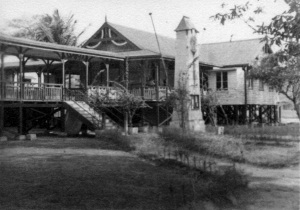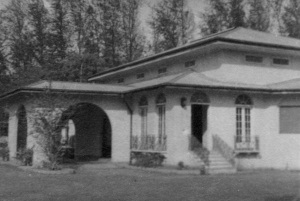 Government Offices, Rabaul |
  New Guinea Club, Rabaul, 1941 |
Rabaul (it means ‘mangrove swamp’ in the local Kuanua language) is located in a volcanically active area at the north-eastern tip of the island of New Britain in what is now the independent state of Papua New Guinea.
Rabaul’s magnificent deep water harbour is a flooded three kilometres wide caldera. From 1870 traders operated in the New Guinea islands and, in 1875, Australian Methodist missionaries established their first stations in the area.
In 1878 a German firm established a commercial outpost on Matupit Island near the present-day town. The settlement became a coaling station and eventually a major trading centre Rabaul developed into a fine town with elegant colonial buildings, wide tree-lined avenues, tramways, a range of facilities and an important wireless station at Bitapaka to the south.
In 1884 the German government raised flags formally claiming the New Guinea islands and the northeast mainland. The Neu Guinea Compagnie was given a charter to administer the region, later expanded to include what is now Bougainville. In 1899 the Imperial German Government took control, in 1910 moving its administrative headquarters to Rabaul.
In September 1914, upon the outbreak of World War I, an Australian expeditionary force of 1500 men captured Rabaul. German New Guinea became an occupied territory. This force was the first to leave Australia under the command of Australian officers and on board its own ships. Part of the force landed at Herbertshohe (now Kokopo) to capture the Bitapaka wireless station.
In the ensuing battle, Able Seaman WGV Williams RAN became the first Australian casualty of World War I. Australian troops hoisted the British flag in Rabaul on 13 September 1914. At the 1919 post-war Paris Peace Conference, Australian Prime Minister William Morris Hughes argued for the annexation of the former German New Guinea.
At the end of the following year, under Article 22 of the Covenant of the League of Nations, Australia was granted a Mandate over the colony, which became the Territory of New Guinea with its administrative centre in Rabaul. The Mandate obliged Australia to take charge of the “spiritual interests of the natives and their development to a higher level of culture” and prohibited “the military training of the natives, otherwise than for the purposes of internal police and the local defence of the territory…”
It also proscribed the establishment of military or naval bases or fortifications. In May 1921, military administration of the Mandated Territory ceased and civil administration began, with an expectation it would operate without external subsidy. German plantations and assets were expropriated and war reparations paid to Australia.
Under Australian Administration, Rabaul continued to prosper as a vibrant regional headquarters and the largest town in New Guinea. It boasted every conceivable civil and social amenity during a period Christine Winter has termed “a brotherhood of whiteness”. There was an active soldier resettlement program, mainly exploiting existing plantation holdings. Australian ex-servicemen from World War I became a dominant presence both on plantations and amongst Administration officials, to the extent that Rabaul was sometimes referred to as “a suburb of Anzac.”
The Australian settlers saw themselves as permanent not temporary residents, and were intent on forging a life in New Guinea. Rabaul became their town. By the late 1930s the population of Rabaul numbered almost 5000 – 800 Europeans, 1000 Asians and 3000 indigenous workers who were employed in police, in government and as labourers and servants.
On 1 July 1937, Territories Minister and former Prime Minister, William Morris Hughes, reacting to suggestions that Hitler might be appeased by the return of former German colonies, told an audience in Rabaul that New Guinea was Australia’s and “all hell is not going to take it away.”
